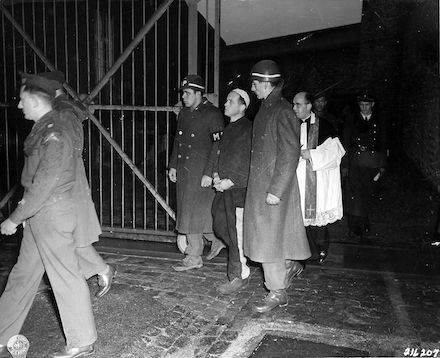This date in 1779 saw the execution in Worcester, Mass., of one Robert Young, a schoolteacher who favored the occasion with the following verse from his very own quill.
The man’s offense one may derive from his confessional, but apart from rapist who was this doomed poet? We refer the reader to the biography at friend and sometime guest-poster Anthony Vaver over at Early American Crime. (Vaver’s book Bound With An Iron Chain: The Untold Story of How the British Transported 50,000 Convicts to Colonial America comes recommended for those interested in the period.)
ATTEND, ye youth! if ye would fain be old,
Take solemn warning when my tale is told;
In blooming life my soul I must resign,
In my full strength, just aged twenty-nine.But a short time ago, I little thought
That to this shameful end I should be brought;
But the foul fiend, excepting God controuls,
Dresses sin lovely when he baits for souls.Could you the monster in true colours see,
His subject nor his servant would you be;
His gilded baits would ne’er allure your minds,
For he who serves him bitter anguish finds.Had I as oft unto my Bible went,
As on vain pleasures I was eager bent,
These lines had never been composed by me,
Nor my vile body hung upon the tree.Those guilty pleasures that I did pursue,
No more delight — they’re painful to my view;
That monster, Sin, that dwells within my breast,
Tortures my soul and robs me of my rest.That fatal time I very well remember,
For it was on the third day of September,
I went to Western, thoughtless of my God,
Though worlds do tremble at his awful nod:With pot-companions did I pass the day,
And then direct to Brookfield bent my way,
The grand-deceiver thought it was his time,
And led me to commit a horrid crime.When it was dark I met the little fair,
(Great God forgive, and hear my humble pray’r)
And, O! dear Jane, wilt thou forgive me too,
For I most cruelly have used you.I took advantage of the dark’ning hour,
(For beasts always by night their prey devour)
This little child, eleven years of age,
Then fell a victim to my brutal rage;Nor could the groans of innocence prevail;
O pity, reader, though I tell the tale;
Drunk with my lust, on cursed purpose bent,
Severely us’d th’unhappy innocent.Her sister dear was to have been my wife,
But I’ve abus’d her and must lose my life;
Was I but innocent, my heart would bleed
To hear a wretch, like me, had done the deed.Reader, whoe’er thou art, a warning take,
Be good and just, and all your sins forsake;
May the Almighty God direct your way
To the bright regions of eternal day.A dying man to you makes this request,
For sure he wishes that you may be blest;
And shortly, reader, thou must follow me,
And drop into a vast eternity!The paths of lewdness, and these base profane,
Produce keen anguish, sorrow, fear and shame;
Forsake them then, I’ve trod the dreary road,
My crimes are great, I groan beneath the load.For a long time on sin should you be bent,
You’ll find it hard, like me for to repent;
The more a dangerous wound doth mortify,
The more the surgeon his best skill must try.These lines I write within a gloomy cell,
I soon shall leave them with a long farewell;
Again I caution all who read the same
And beg they would their wicked lives reclaim.O THOU, Almight GOD, who gave me breath,
Save me from suffering a second death,
Through faith in thy dear SON may I be free,
And my poor soul ascend to dwell with Thee.
On this day..
- 2009: Ehsan Fatahian, Iranian Kurdish activist - 2020
- 1919: Wesley Everest lynched during the Centralia Massacre - 2019
- 1942: Ernst Schrämli, Swiss traitor - 2017
- 1807: Ephraim Blackburn, low roller - 2016
- 1954: Karli Bandelow and Ewald Misera, in the Gehlen-Prozess - 2015
- 1674: Guru Tegh Bahadur - 2014
- 1806: Fra Diavolo, royalist guerrilla - 2013
- 1328: Na Prous Boneta, Beguine heresiarch - 2012
- 1880: Ned Kelly - 2011
- 1761: John Perrott, bankrupt debtor - 2010
- 1909: Will James, "the Froggie", lynched in Cairo - 2009
- 1887: Parsons, Spies, Fischer and Engel, the Haymarket Martyrs - 2008
- 1831: Nat Turner - 2007



 You’ll need Spanish for most sources on this
You’ll need Spanish for most sources on this 
 The son of a
The son of a